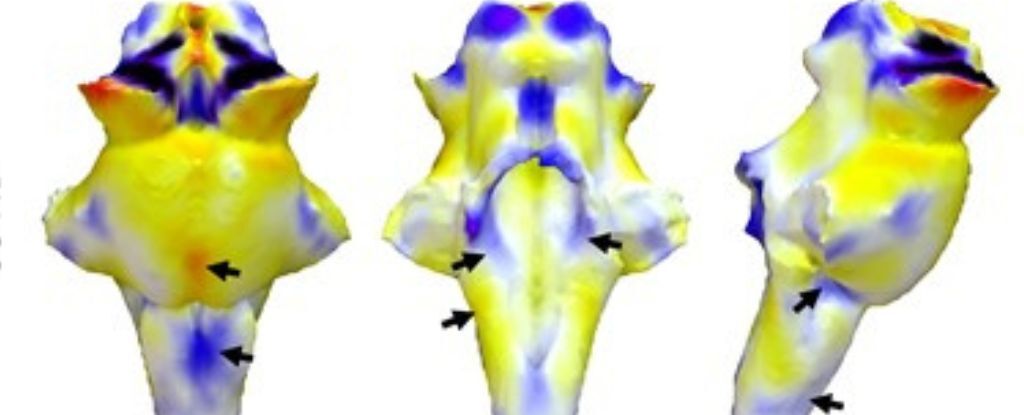All those people who refused to take COVID seriously have a lot of blood on their hands.
Shout out to Physics Girl Dianna. Who is still bedridden.
STILL? I haven’t checked in months. That’s crazy.
yeah her YouTube channel still posts updates from time to time. shoutout to her husband too. they got married and almost immediately became patient/caretaker. it’s probably exhausting for both but they’re both resilient, hopefully they’ll get out of it and live a stress free happy life. sure deserve it after going through this.
She has shown small improvements, but it’s excruciatingly slow.
They don’t remember. On account of their brain injury.
No, not everyone who got long covid didn’t take it seriously. But the people who were super spreaders or spread misinformation are certainly to blame.
deleted by creator
But fortunately a lot of them don’t care about such things as the quantity of blood on their hands, so news like this won’t worsen their lives or self-image.
They got their Applebees. Does’t matter.
Removed by mod
Vaccines has been around for centuries. It’s people like you, who think they “know better” that are partly at fault for lots of COVID deaths.
The worst part is you are not changing even when proven wrong, the vaccines saved hundred of thousands of people.
Smh
Removed by mod
You know vaccines work by stimulating your immune system, right? If you actually take the time and effort to try and understand something, you don’t have to trust the government fully to come to the conclusion that the vaccine is safe.
It’s just too bad you all facilitate the weak to reproduce. There’s a lot of blood on your hands.
Are you suggesting we’re all bad people for not engaging in eugenics?
Better not get surgery or go to the dentist, the government will probably inplant tiny radios in your teeth to control your brain.
Remember how people like you said billions of people were going to die because they got the vaccines and then billions of people got the vaccines and didn’t die? And then a bunch of people who didn’t get the vaccines died of COVID?
Because the rest of us do remember that. And we’re still alive.
Removed by mod
Lump myself in with who, people who say not to take vaccines? Because those are people like you whether you want them to be or not.
I, on the other hand, encourage taking every vaccine you have the option to take.
Removed by mod
This you?
or trust authorities telling them to inject some shit?
Because that’s the “character in my head” I’m talking to.
Edit: This also you?
Oh look. A bunch of words. I’d better inject myself because everyone I’ve ever met is soooo trustworthy.
You know what’s been around longer? My immune system. It’s been millennia. It’s just too bad you all facilitate the weak to reproduce. There’s a lot of blood on your hands.
Removed by mod
Eh what a dumpster fire take.
Also, if you wanted to try to fool simpler minds than yours into believing you are informed, and not an inbred mouth breather, at least attend to your spelling. ‘Indites’ is not a word. You and MTG really struggle with that one hey?
Removed by mod
I really don’t believe you went with the archaic spelling over the standard one on purpose. If you did, why?
https://www.grammarly.com/commonly-confused-words/indict-vs-indite
They’re trying to tell me that I’m imagining their antivax take. I think they just want to try to get away with saying ridiculous things by pretending they either never said them or said them on purpose despite that being silly.
Removed by mod
Sure, go for it. What words did I put in your mouth? Please do show me.
Removed by mod
So you meant to say “Cincinnati will literally compose people without a shred of evidence” ?
Is that correct?
where can i learn more about how bad things are? do you have any places you normally go to find out the truth?
Ooo interesting. The parallels with CFS are fascinating.
I wasn’t even aware of that. chronic fatigue syndrome was actually real.
I thought I was just like side- depression.
is there anything known about CFS?
what causes it or how long it lasts or anything?
I know nothing about it except for like a comedy sketch from the 2000s at some point.
Lifelong disease usually triggered by viral infections. Very functionally disabling.
Known immune abnormalities which seem to affect the brain and mitochondria. I think @[email protected] is specialised in it.
Also “chronic fatigue syndrome” was the name back when it was classified as psychological. Now that it’s classified as neuroimmune the name has been changed to Myalgic Encephalomyelitsis (ME) (Or ME/CFS).
As usual though for a medium quality source like ScienceAlert, the article is written by someone who has no specialisation in Long COVID/ME, or even medicine. So there’s a bit of oversimplification and overstating findings from one study in that article. Very few researchers think it’s a brain injury. Most think the immune system has been compromised (with some deficiencies and abnormalities) and it’s affecting the brain in unknown ways (hence the abnormalities found. It’s weird though because the immune system problems seem to cause some immunodeficiencies but also autoimmune reactions. They’ll need to be quite a bit more studies before we get a clear picture.
Couldn’t have said it better. And yes, science journalism often is basically repeating and dumbing down what a study says, but in science, and especially in medicine, a lot of studies tend to be wrong, make false assumptions, or overstate their findings, while journalists tend to take them for their word. There’s a reason you hear of a new cancer treatment in the news every other week but few actually make it past FDA approval.
wow, thank you so much for the detailed answer, I’m fascinated chronic fatigue syndrome turned out to be a neuroimmune disorder.
is ME genetic or do you just get unlucky as far as we know so far?
We don’t really know. But theres a giant GWAS (Genome Wide Association Study) called Decode ME with I think upwards of 25’000 pariticpants which is coming out in the next year. So we’ll know a whole lot more then. Hopefully it might lead to treatments.
thanks, I totally slept on those developments.
that is very exciting
Seems like it generally just gets triggered by a viral infection, but obviously it’s hard to find conclusive evidence for that as people get viral infections all the time and usually recover fine. In a way COVID was a useful ‘experiment’ where we got a lot of cases of people getting long COVID right after a confirmed infection (because everyone was getting tested, which you typically wouldn’t do for your average viral infection).
Yeah. Atleast 50% report an onset right after a viral infection. And it’s not impossible to assume the other 50% were caused by viral infections too but the patient didn’t make the connection. Obviously we don’t really know yet.
Yeah, would be hard to prove unless people started routinely testing themselves for a broad array of viruses every time they fall ill.
But hopefully with the influx of long COVID patients more research will be done, and people with CFS, fibromyalgia and similar diseases will at least be believed, because all of those are typically dismissed because you can’t really see it.
triggered or caused by?
fascinating, thank you.
that makes sense, we must have so much new data on how viruses affects humanity as a whole because of the global testing going on so long for so many people.
Probably triggered. But we don’t really know.
what an exciting development we still have to look forward to.
I mean, it’s probably some sort of autoimmune thing, where the infection causes the immune system to go haywire and attacks your own body.
That’s so cool of immune systems, to sometimes do that.
CFS is a syndrome rather than a disease because, until recently, it only presented as symptoms instead of as an identifiable problem with a person. I know that a some people who get diagnosed for CFS get later diagnoses as neurological disorders like multiple sclerosis.
It sounds like the more powerful MRI scanners are seeing inflammation in the rest of those suffering from CFS.
That would mean CFS is a lifelong degenerative condition.
Hey I’m a researcher who works on ME (in the past called CFS).
ME/CFS is currently classified as a disease/biological illness according to the CDC.
ME is a disease state in itself. We don’t know much about it, but it can’t be explained by other diagnoses, as the defining factor, neuro-immune abnormalities including immune activation showing up post exertion is unique to it. You’re completely right that we don’t yet have a reliable biomarker. We have a test that differentiates from healthy controls, but it was discontinued for ethical reasons because conducting the test leads to a sometimes permanent worsening of the illness.
In the past it’s been mixed up and jumbled a lot, but the picture is getting clearer.
There have been a few case reports of degenerative forms of the illness. But in general it takes a more classical relapsing remitting pattern. Although even in less bad stages some patients are severely functionally disabled, even bedridden and tubefed. It has a really wide range of severities with the least severely affected able to work part time and walk and travel, while the most severe might not even be able to communicate.
I have a friend who’s now living with ME. Any resources for the general public to better understand the condition?
This Podcast Will Kill You EP 137: ME/CFS did a great episode. They also have their sources so if you need a deeper dive you can read the articles.
For you to help your friend. Or for your friend themselves?
For me to be a better friend by better understanding his new limitations…
He already has a good support network, they organised a fundraiser to get him an electric wheelchair, which is awesome! But at first I didn’t understand why it was helping him, because I don’t know enough about the condition. 🫣
This channel has a bunch of short (5 mins long videos) about ME to educate people.
There’s also a slightly outdated (but still worth the watch) oscar nominated documentary about it, which has been made free and put on youtube recently It’s Unrest by Jennifer Brea
One of my patients also runs this excellent website with a bunch of resources about the disease.
Hey I’d really love to go into a short (although not necessarily immediate) exchange with you. I have MS diagnosed, recently died (not kidding) possibly due to PROMM and also yet another neurological skin disease and am wondering if my head should maybe be scanned differently now in this context.
I’m sorry I really shouldn’t be giving medical advice. It’s been a long time since I studied neurology. I’ve spent the past decade only on post viral diseases like ME.
But please please find yourself a doctor that listens and cares if that is possible. Because it clearly sounds like you need tests and you need a doc thats available for you. Maybe join some local MS support groups and ask if anyone has docs that do a really good job and try from there.
I’ll tell you this as a doctor. I would stay the hell away from some of my colleagues. Not every doctor is anywhere near good at their jobs. Some don’t care, some barely passed and don’t want to learn anything new, some like to always assume their patients have psychological problems. Find yourself a good doctor who is proactive and cares, and everything will be so much easier. Sending you good luck.
Thank you for your answer and empathy.
Luckily I am already in good care in general and also medically treated (luckily it’s in Europe otherwise I’d be broke and dead).
So regular checkups are there already. However what I miss is the deeper investigation, which might even provide data to research.
It looks like the state of the art has advanced since the last time I was exposed to it. Thanks for the clarification.
this is the extent of what I knew about CFS, I never heard of ME, I thought CFE was still a collection of symptoms that didn’t even indicate a single underlying syndrome.
I like the progress, clearly seeing brain stem inflammation sounds like comic book talk from 20 years ago.
they’re going to see inflamed dendrites next.
oh but isn’t clogged dendrites how they identify multiple sclerosis already?
clearly I have to read more about this. catch up a bit.
thanks for the explanation.
My understanding is that MS is usually defined by the deterioration of the myelin sheath in brain cells which can be detected through MRI’s.
it is, and they can take pictures of the inflamed dendrites and axons showing where they’re clogged, so I was wondering how much smaller these substructures in the brain stem are than dendrites and axons that neurons travel through, which are pretty freaking small and we’ve had pictures of for at least a couple decades now.
oh or maybe those were microscope slides and they’re saying now we can microscopically look at this stuff without having to cut into it.
A collection of symptoms is a syndrome. Once there is a known definite cause, reclassification as a disease can take place. Lay misuse of the terms and reluctance to adopt updated designations have aided in a loss of distinction in what they refer to.
There is something else entirely to be said for how quickly one can progress from the disbelief of a particular diagnosis as anything beyond a punchline to descanting over the marvels of modern medicine as they relate to futher study of the mechanisms. If nothing else, it’s a great reminder of how much information is available to us on a whim.
We all get tired
some of us syndromically
It’s the line from the sketch (it’s the only one I know of from the early 2000s about it). Jesus is healing people of various ailments and someone says they have ME and he responds “well, we all get tired”.
oh ahhah, it rang a bell but I couldn’t remember
Much the same like we all get depressed - a normal & necessary mechanism that if it lasts for too long no longer works & causes damage.
Absolutely. I should have used an /s
It’s a line from a sketch
Oh, sorry, I really wasn’t clear & just
randomly regurgitated from my brainholewrote the thought I thought people (not you specifically) should be aware-ish of (psa, kinda, about how getting depressed is normal and healthy but that clinical depression is something else - but thats hard to explain to people not afflicted by it & using the case of fatigue + your quote seemed like a good place for it … perhaps if I started with “we all get depressed”).I wrote it after I’ve already seen your explanation (it felt like a reference anyway) - but now reading what/how tf I replied it absolutely looks like Im explaining you basic human stuff.
No worries at all, don’t even worry about it.
What’s CFS?
Chronic fatigue syndrome.
It’s another one like long covid where so much of the medical community thinks it’s all in people’s heads and not real, but unlike long covid it’s less prevalent and thus studied less. We still don’t know what it is.
There’s even some hopes that figuring out long covid might lead to new ways to look into what cfs really is.
I wish people cared about dealing with covid still. Once corporate America got that sign off not to care there was no going back.
Seriously. I spent 2 days in the hospital last week with bilateral pulmonary embolisms after having COVID the middle of last month. I was NOT otherwise at risk for clots. A terrible surprise that I’ll no doubt be recovering from for some time. I’m on a blood thinner for 6 months.
Fixed your ED at least 😊👍🏻
great.
remember when all the politicians and people who control things got covid?
What a totally normal and cool planet this is.
They were already shitheads.
A bull in a porcelain shop is not gonna do much damage if the shop is next to empty.
If it makes you feel any better, those demographics were already suffering from lead gas exposure.
I’m still afraid of long-c. I insisted that we wore masks in airports and on flights when we took a trip last month. We live life in a normal fashion everywhere else (because we’re vaxxed and boosted), but I wasn’t willing to risk that environment.
Why just planes? Surely this would apply to all public transport.
If they’re US American, a plane is likely the only public transportation they’ve ever taken. If they live anywhere remotely rural, it’s likely the only one available to them.
Signed, -An American
I was going to say “almost every American takes a school bus at one point in their life” then I looked it up and was disgusted to find that recently more children are driven to school than take the bus.
It’s absolutely ridiculous how many people drive their kids to school. The traffic reduction during fall break last week was astounding.
It’s absolutely ridiculous how hard the school systems make it to get on a bus route.
You basically have to stay at the same residence and at the same school for their entire education. Even just moving within the district and they use it as an excuse to “put you on a wait list”.
Add in the shortage of drivers (who wants that job) and any excuse they can use to change boundaries or cut a route.
It’s like the fucking DMV on steroids.
I am curious where you are located, this has not been my experience working closely with our schools.
That is crazy. I didn’t realize how bad it is in some areas. I live in a red state and have moved every year or two, and was able to get bus service with very little issue.
However, that does sound like the struggle with getting after school care. You pretty much need to get in the back of the line for every school and hope you’ll get a spot so you can continue to work and pay rent.
It is honestly necessary sometimes. My daughter was eventually taken out of school by us entirely and put in a (public) online school because of how severely she was being bullied, but before that, we had to take her to school because she could handle getting on the bus with all the kids being horrible to her every morning and afternoon.
For a while, she was allowed to listen to an mp3 player with earbuds, but then they started just shouting over the earbuds. And bus drivers barely give a shit considering how low they’re paid.
So yeah, sometimes people drive their kids to school for a reason.
But 53% of people??
Considering the current division, yes. There’s also a lot of homeschooling because they don’t want their children taught anything from ‘state’.
The school buses don’t have seatbelts.
Airports and planes see a lot of traffic from all over the world constantly rotating through. With some variation depending on the size of the city and your personal schedule, you’re running into more of the same people on normal public transport.
And you’re in very close proximity for a very long time. I don’t know how HVAC works on an aircraft but I assume there’s a large amount of recirculation.
I was on buses and trains this morning. They weren’t nearly as crowded, the trips were a lot shorter, the air moved around at every stop, and like you said, they’re all pretty local, so low risk of someone importing weird diseases. At least on the subways, you should still wear a mask if only because of the air quality. There’s a lot of brake dust floating around.
The filtration system on an airplane makes it one of the safer places to be for almost any airborne infection. The airport itself is much more dangerous, longer flights notwithstanding.
I walk to work ten minutes to work. Partner and I each have cars. We take uber when we want to avoid driving.
Do masks help the wearer? Last time I heard it didn’t. Probably wrong.
Either way, good for you…even if it only helps others that’s a good reason!
N-95 masks are protective, and to a certain (most likely lesser degree), KN-95 masks are also protective.
They still block droplets from reaching the wearer.
N95 masks block more than droplets too, they are quite effective
The droplet theory was dropped within the first few months. It turns out it’s not just COVID; many infections we thought were spread by droplets are actually airborne.
Oh, thanks for the info. How effective are n95s and/or surgical/cloth masks given that information?
Surgical/cloth are pretty much useless for COVID. N95s buy you temporary protection unless you’ve got the special face fittings needed to actually seal your face. It depends on the environment you’re in but the worst case scenarios (like enclosed spaces without high airflow), the last study I saw was on the Delta variant and they said about 15 minutes if both parties are masked. It does get better from there though, with good ventilation you might have a few hours, and being outdoors you’re actually pretty safe.
It helps to check whether or not the things you say are true before you declare them.
In this case, it is not true that they are “pretty much useless for COVID.”
This article is from before they dropped droplet theory later in 2020. In the section titled “Factors to Consider when Using Cloth Masks to Protect Wearers and to Prevent Spread of Infection during the COVID-19 Pandemic”:
The primary transmission routes for severe acute respiratory syndrome coronavirus 2 (SARS-CoV-2) are thought to be inhalation of respiratory droplets and close contact; therefore, WHO recommends wearing medical masks during routine care and using respirators during aerosol-generating procedures and other high-risk situations (17). However, SARS-COV-2 is a novel pathogen, and growing evidence indicates the possibility of airborne transmission.
They then go on to explain that cloth masks are the option of last resort and are not very useful. Surgical masks with proper fitting around the face and a certain minimum rating for water resistance will help, but most of the “surgical” masks we were all buying do not have enough layers and no water resistance ratings, and who among us got training on how to properly fit a mask to our faces?
Dropping a link and calling it information when you don’t understand the content or haven’t read it is not productive.
Masks help, but Masks plus Faceshield or some sort of eye protection is best.
As someone with long COVID, I can vouch the debilitating mental effects. I was teaching math to 4th through 8th grade students when I got it. I can remember standing in a classroom talking about a lesson and just having my mind go blank in mid sentence. I couldn’t function. Not knowing what I was talking about or even where I was. Thankfully the students where very understanding and someone would finish my point I was making. I still suffer from it yet today, nearly 2 years later.
I have respiratory issues despite every CT scan showing nothing more than a couple of small pneumonia scars form long ago. I should be able to breathe just fine with no reduction of lung capacity. It stems from a lack coordination with my diaphragm - It runs backwards when I exert myself causing shortness of breath. Another sign of probable brain injury. And despite using a therapy tool to try and fix the issue, at best it just helps a little.
The upshot is I have pretty much stopped doing a lot of things I used to do because of the difficulties breathing and I spend a lot more time away from people due to an unreasonable fear of COVID.
It has caused me to retire earlier than I wanted to. And my life has greatly changed - and not for the better either.
Sorry you’re going through all of that. There obviously aren’t any long term studies on it yet, but hopefully things will improve more and more over time.
According to my Pulmonolgist - Nope. Her observations of all her patients over the years is that if you don’t get over it in about a year, you don’t get better. And she has been seeing more COVID patients than her “normal” patients for several years now. Long term care is going to be a real problem for society going forward.
I mean this in the kindest way possible, but have you tried both mental and physical therapy?
First, thank you for your concern. You are a good person and a credit to yourself.
I suppose mental therapy might be a path I could follow. But it’s more a concern of getting COVID yet again and I’m old and in the high risk age group. And despite being vaccinated and getting boosters as needed, there is frankly no guarantee I won’t get it again. It’s not that I shun contact and interaction with others, I certainly don’t. But minimizing contact with crowds is medically a good thing for me. And messing around in a town/city a lot is asking for trouble. I’m close enough to the end of life that I don’t need the extra help in getting there - it’s coming soon enough as is.
I did do therapy with a Speech Therapist, it’s where I got the breathing device. They are oddly well qualified for issues like mine. But, evidently COVID can create a short circuit in the brain that physical therapy can help some but really can’t fix according to my Pulminologist and the Speech therapist. And as far as just getting plain exercise goes, I live in a very rural part of a very large forest. And between daily chores, I spend copious amounts of time in that forest foraging until the snow flies and at this time of the year hunting. In fact, if it stops misting and the fog lifts this afternoon, I will be out with a dog doing some grouse hunting chasing after supper. I don’t quit because of limitations. Quitting brings on death much faster. And I’ve seen that enough during my many years as a medic.
I hate the changes that COVID has forced upon me. But I acknowledge it’s existence and I’m fighting it as hard as I can.
*a reasonable caution of encountering people with an unreasonable response to covid
What turns regular COVID into long COVID? When I got COVID I was better after 2 weeks but I had a nagging cough and chest discomfort for 2 months
It’s very subjective. You can read more about it by searching around, but the prevailing definition means people who had more severe reactions to the infection than the average patient, which almost unanimously means a severe and prolonged inflammatory response.
What they are finding more and more is that this specific virus triggers undiagnosed or dormant autoimmune responses in patients. If you’re familiar with Rheumatism at all, imagine a massive reaction to, say, twisting your ankle, but it goes out of control and causes swelling all over your body including your brain, lungs, heart, and renal system. This is actually what killed the most patients pre-vaccination.
The full body assault of an inflammatory response just makes the body unable to cope, and things start shutting down. It can kill children and older people very easily if you can’t get it under control. Many succumbed to Pneumonia, but those that lived had damage to their major internal organs from the inflammatory response. You can also see some had been using the term “Walking COVID”, meaning people who had cleared the infection, but had long term sustained symptoms similar to Emphysema. They’ve since just moved on to calling everything “Long COVID”. Some people recover, some people don’t.
This study finally identified the specific damage and detection to brain activity.
People don’t get it. The inflammatory process can do these sort of thing to any organ or system, or parts of them.
People got a thing called COVID Toe. This is where you and every person already has some fungus that live on their feet and which gets into the skin and toenails. Maybe you have a little yellowing of the toenails or you’re just “prone to athletes foot.”
Then you get COVID and suddenly your immune system is working overtime. The fungus starts to multiply faster and spreads more aggressively. Your toes start to get itchy and red, more than usual. They swell. They yellow. Then they start to crack and ooze, possibly requiring surgical debridement or in the most severe cases, such as where the patient already had diabetes affecting their peripheral nerves, amputation of the foot to prevent necrosis and sepsis. Imagine dying from athletes foot because your immune system was overwhelmed fighting a coronavirus.
Interesting. I had an increase in fungal presence, but I figured it was excessive boot usage due to starting motorcycle riding 5 months after my first covid infection. It clear near winter for the most part but I wonder if I just hadn’t noticed the initial spread.
Very possible. There was a group of podiatrists who wanted to add athletes foot as a primary symptom of COVID. I can’t seem to find their letter right now. Google really sucks these days.
It’s a serious virus. People don’t realize. Just because most people fight it off like a flu doesn’t mean is was as easy on your body for it to do so. Imagine if we had a president that didn’t treat it as a joke. Might be a few million people still alive.
Is it this one? https://jfootankleres.biomedcentral.com/articles/10.1186/s13047-020-00425-9
I’ve been using duck duck go these days
Nah, it was a letter signed by a bunch of doctors to some medical society or another.
Diana from YT Physics Girl has long COVID. Her very loving husband takes care of her. We all wish them the best and any kind of recovery.
deleted by creator
Tainted?
Love?
Oh
deleted by creator
So what I’m hearing you say is we should ignore it and act like all the people who correctly point out how dumb we’re being are assholes.
Using high-resolution scanners, researchers at the Universities of Cambridge and Oxford have shown microscopic, structural abnormalities in the brainstems of those recovering from COVID-19.
Signs of brain inflammation were present up to 18 months after first contracting the SARS-CoV-2 virus.
[…]
In living brains of those with long COVID, however, conventional MRI studies have shown no structural abnormalities in the brainstem.
Do these people not proof-read their own articles?
Normal hospital-type MRI scanners can’t see inside the brain with the kind of chemical and physical detail we need. But with 7T (7 Tesla) scanners, we can now measure these details
Not the best article, but I think what they are trying to say over multiple paragraphs is that new higher resolution MRI machines can see the damage that normal lower resolution MRI can’t see
what type of abnormalities are they seeing specifically?
FTA: Signs of ongoing inflammation in the brainstem, something that is seen in people with traumatic brain injury and people with chronic fatigue syndrome.
oh, interesting.
so this new study is saying they can see on a small enough scale to find that scientifically consistent and significant inflammation in the brainstem directly linked to covid?
Precisely. They had previously been unable to see this in living patients due to limitations of typical MRI machines but had found signs in the deceased. The major change is that, using a more powerful (7 Tesla) MRI machine, they were able to see these same symptoms in living patients for the first time.
okay, got it. thanks.
that is a heck of a development, I now understand the cause for the hullabaloo.
You’re very welcome! Glad that I could help.
Removed by mod
deleted by creator
Who hurt u?
The abnormalities are only visible with a 7T scanner, and not conventional MRIs.
yes, I can guess that explanation when trying to figure out the seeming contradiction. I don’t read scientific articles to end up guessing because the author can’t string together a well structured text. :)
No guesswork was needed, only a modicum of reading comprehension.
Dude read the rest of the article
I have to choose what to spend my time on. If an article contradicts itself that obviously after I spent 2-5 minutes reading, I’ll go look for more intelligent texts.
It’s not contradicting itself though. Your first quoted statement says “using high-resolution scanners”. The last one says “conventional MRI studies”. The methodology is what is different.
Let me break it down so you see the point I was making - in case the bold wasn’t enough:
Using high-resolution scanners, researchers at the Universities of Cambridge and Oxford have shown microscopic, structural abnormalities in the brainstems of those recovering from COVID-19. Signs of brain inflammation were present up to 18 months after first contracting the SARS-CoV-2 virus.
Here, they refer to people recovering from COVID-19, thus clearly indicate that patients are alive.
[…] In living brains of those with long COVID, however, conventional MRI studies have shown no structural abnormalities in the brainstem.
This paragraph immediately follows one that talks about autopsy(!) results, and here, they start a sentence with “in living brains […], however”, setting the sentence up as a contradiction to the previous one, with an emphasis on the word living in the article itself.
Here’s an example how the sentence should be written to not seemingly cause a contradiction / misdirect the reader:
However, previous studies conducted with conventional MRI had shown no structural abnormalities in the brainstem in living brains.
They put emphasis on the change in observation from autopsy to living brains, linking this paragraph more strongly to the preceeding one, when they should have put emphasis on the conventional studies, building the context for the subsequent paragraph.
I don’t really understand what the difference between the fixed and og version is.
The fixed version is slightly is better, I agree, but I wouldn’t call it a necessary fix.
You are judging a field specialist(s) on basically their communication skills. We can’t all structure sentences well, brainholes work differently, wording thoughts is hard.
It’s a bit like bitching how a perfectly working shovel isn’t ornate enough since if it was it would have been more pleasant to work with - it’s prob true but it’s such a low gain ‘nice-to-have’ feature people generally don’t bother with it.
Imho narratives need to be pleasant and/or artistic, eg I expect a novel to be written good (tho absolutely not a huge point for me), I don’t expect that from a game theory book, I expect it to be correct. (Another example might be how stupidity convoluted laws/contracts/t&a are written.)
What I kinda demand (only slightly irrationally or at least to an impractical extend) is that the subject is conveyed in an exact manner. I expect exact communicating overall.
And the og text you quoted is exact.
Oh … and at both ends it’s literacy - their (+to some extend whoever proofread it) literacy levels shows how eloquently they conveyed their data & thoughts, your literacy level shows how you though they are contradicting themselves.
You are judging a field specialist(s) on basically their communication skills.
“Carly Cassella is a Senior Journalist at ScienceAlert”
Or am I?
Also, it’s not my fault that people got all flustered about me simply pointing out that poor phrasing with “do they even proofread?”
Edit: goat -> got
Oh, a journalist, then bitch on :D (no /s, after all, random bitching is a fair part of lemmy).
But I think people replied to your og message because of the (mis?)use of the word “contradictory”, not because of the bitching as such.
(And Im mostly here bcs I like to understand myself, like what triggered you sceptically & how the same thing played in my mind)














